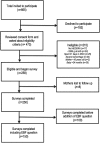Delivery mode and breastfeeding outcomes among new mothers in Nicaragua
- PMID: 28621054
- PMCID: PMC6866214
- DOI: 10.1111/mcn.12474
Delivery mode and breastfeeding outcomes among new mothers in Nicaragua
Abstract
Breastfeeding has been shown to benefit infants and mothers. Women who have caesarean deliveries (C-sections) are expected to be less likely to initiate and continue breastfeeding than those who have vaginal deliveries. Given the high rate of C-sections in Nicaragua, the importance of breastfeeding, and the centrality of culture in choices about breastfeeding, this study sought to examine if mode of delivery relates with breastfeeding initiation and exclusivity in Nicaragua. Two hundred fifty mothers were surveyed about birth experiences and breastfeeding behaviour in 3 public clinics in León, Nicaragua, between June and August 2015. Logistic regression analyses were performed to examine the association of mode of delivery with initiation of breastfeeding within 1 hr of birth (early initiation) and exclusive breastfeeding for 6 months post-partum. The rate of early initiation was 68.8% and that of exclusively breastfeeding for 6 months was 12.7%. Mode of delivery was not significantly associated with early initiation (p = .383) or exclusive breastfeeding (p = .518). Early initiation was negatively associated with prelacteal feeding, AOR = 0.30, 95% CI [0.16, 0.58]; p = .001. Mothers who had perceived their infants as large at birth were significantly less likely to exclusively breastfeed for 6 months, AOR (95%CI) = 0.25 (0.06-0.97); p = 0.046. Mode of delivery was not significantly associated with optimal breastfeeding initiation and exclusivity among mothers in Nicaragua. The 2 risk factors identified for delayed initiation of breastfeeding and lack of exclusive breastfeeding were prelacteal feeding and maternal perception of a large infant at birth, respectively.
Keywords: Latin America; breastfeeding; breastfeeding outcomes; caesarean delivery; mode of delivery; prelacteal feeds.
© 2017 John Wiley & Sons Ltd.
Conflict of interest statement
The authors declare that they have no conflicts of interest.
Similar articles
-
Effect of cesarean section on initiation of breast feeding: Findings from 2016 Ethiopian Demographic and Health Survey.PLoS One. 2020 Dec 18;15(12):e0244229. doi: 10.1371/journal.pone.0244229. eCollection 2020. PLoS One. 2020. PMID: 33338080 Free PMC article.
-
Determinants of infant breastfeeding practices in Nepal: a national study.Int Breastfeed J. 2019 Apr 3;14:14. doi: 10.1186/s13006-019-0208-y. eCollection 2019. Int Breastfeed J. 2019. PMID: 30988689 Free PMC article.
-
The impact of caesarean section on breastfeeding initiation, duration and difficulties in the first four months postpartum.BMC Pregnancy Childbirth. 2016 Apr 26;16:90. doi: 10.1186/s12884-016-0876-1. BMC Pregnancy Childbirth. 2016. PMID: 27118118 Free PMC article.
-
Role of breast-feeding in the prevention and treatment of diarrhoea.J Diarrhoeal Dis Res. 1990 Sep;8(3):68-81. J Diarrhoeal Dis Res. 1990. PMID: 2243179 Review.
-
Associations between caesarean births and breastfeeding in the Middle East: a scoping review.East Mediterr Health J. 2021 Sep 21;27(9):931-940. doi: 10.26719/emhj.21.027. East Mediterr Health J. 2021. PMID: 34569049
Cited by
-
Prevalence and Associated Factors of Caesarean Section and its Impact on Early Initiation of Breastfeeding in Abu Dhabi, United Arab Emirates.Nutrients. 2019 Nov 10;11(11):2723. doi: 10.3390/nu11112723. Nutrients. 2019. PMID: 31717627 Free PMC article.
-
Breast and complementary feeding in Ethiopia: new national evidence from systematic review and meta-analyses of studies in the past 10 years.Eur J Nutr. 2019 Oct;58(7):2565-2595. doi: 10.1007/s00394-018-1817-8. Epub 2018 Sep 18. Eur J Nutr. 2019. PMID: 30229308
-
Breastfeeding practices in Masaya, Nicaragua: a facility based cross-sectional study.Int Breastfeed J. 2020 Apr 22;15(1):31. doi: 10.1186/s13006-020-00273-0. Int Breastfeed J. 2020. PMID: 32321564 Free PMC article.
-
Association between breastfeeding, host genetic factors, and calicivirus gastroenteritis in a Nicaraguan birth cohort.PLoS One. 2022 Oct 14;17(10):e0267689. doi: 10.1371/journal.pone.0267689. eCollection 2022. PLoS One. 2022. PMID: 36240197 Free PMC article.
-
Early initiation of breastfeeding up to six months among mothers after cesarean section or vaginal birth: A scoping review.Heliyon. 2023 May 24;9(6):e16235. doi: 10.1016/j.heliyon.2023.e16235. eCollection 2023 Jun. Heliyon. 2023. PMID: 37292274 Free PMC article.
References
-
- Angel‐Urdinola, D. , Cortez, R. , & Tanabe, K. (2008). Equity, access to health care services and expenditures on health in Nicaragua. Washington, DC: The World Bank; Retrieved from http://www.worldbank.org/.
-
- Balci, E. , Kondolot, M. , Horoz, D. , Elmali, F. , Çiçek, B. , & Demirtaş, T. (2012). The factors affecting the duration of breastfeeding: A cross‐sectional study from Kayseri, Turkey. Turk Pediatri Arsivi, 47(2), 99–103. 10.4274/tpa.754 - DOI
Publication types
MeSH terms
LinkOut - more resources
Full Text Sources
Other Literature Sources
Medical


